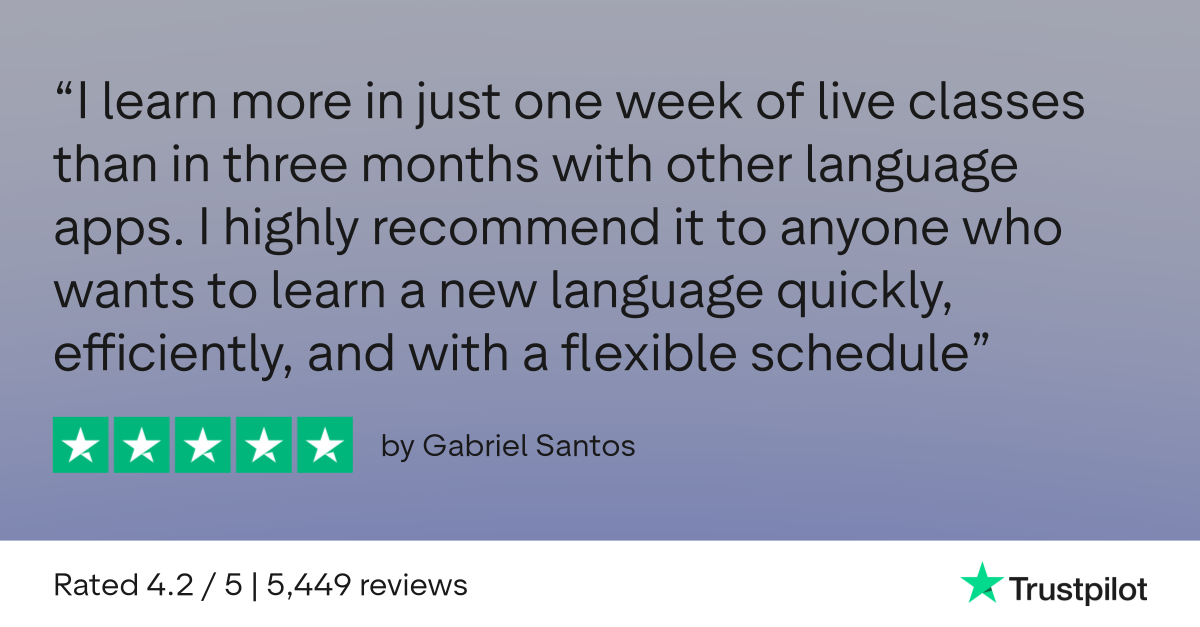Possessive adjectives in Spanish
Possessive adjectives in Spanish are a fun concept to learn for anyone who wants to speak Spanish more fluently. These words help us express the ownership of objects, relationships, or abstract nouns in passing.

If I talk about my dog (mi perro), my family's vacation (nuestras vacaciones) or ask about your work (tu trabajo), possessive adjectives are crucial. So what are possessive adjectives in Spanish? They are words that appear before or after a noun to show who that noun belongs to.
Today we'll cover the different types of possessive adjectives in Spanish and when to use them, plus we'll show examples of how native Spanish speakers would use them so you can sound like a natural.
- What are possessive adjectives in Spanish?
- Types of possessive adjectives in Spanish
- How and when to use possessive adjectives
- FAQs
What are possessive adjectives in Spanish?
The 10 possessive adjectives in Spanish are: mi, tu, su, nuestro/a, vuestro/a and their respective plural forms mis, tus, sus, nuestros/as, vuestros/as. Once you get the hang of them, your conversations become clearer and more natural, revealing a lot from just a few words.
We covered the basics in a previous post about the most common Spanish adjectives, so today we'll go over specifics. Possessive adjectives in Spanish describe who owns something.
- mi bicicleta (my bicycle)
- tu cara (your face) - informal you
- su pasaporte (your passport) - formal you
- nuestro carro (our car)
- vuestra casa (your house) - plural "y'all's car"

Learn Spanish with Lingoda
How it works

Types of possessive adjectives in Spanish
There are two types of possessive adjectives in Spanish. Short-form adjectives and long-form adjectives differ in how they are written, their syntax or placement, as well as what they are used for.
Short-form (unstressed) possessive adjectives
Short-form possessive adjectives are used before the noun in Spanish. When writing them, they do not have a vocal stress or accent mark in Spanish.
| Spanish | English |
| mi/mis | my |
| tu/tus | your |
| su/sus | her/his/itsyour (formal) |
| nuestro/a/os/as | our |
| su/susvuestro/a/os/as* | your (plural) |
All of the examples used in this article have been short-form so far. Take a moment to scroll up and see.
Long-form (stressed) possessive adjectives
Long-form possessive adjectives are used after the noun in Spanish. The first-person long–form possessive adjective in Spanish has a visual marker. The tilde (´; accent mark) in mío/mía points to the right. Remember these possessive adjectives go to the right of the noun for added emphasis.
| Spanish | English |
| mío/mía | mine |
| tuyo/tuya | yours |
| suyo/suya | hers, his, itsyours (formal) |
| nuestro/a | ours |
| suyo/suyavuestro/a* | yours (plural) |
Examples:
- El suéter es mío. (The sweater is mine.)
- La idea es tuya. (The idea is yours.)
- La responsabilidad es suya. (The responsibility is yours.)
- De esas pinturas, la verde es nuestra. (Of those paintings, the green one is ours.)
- El premio no es mío, es vuestro. Se lo merece. (The award is not mine, it's yours. You deserve it. - formal)
*Note: vuestro/a/os/as is a conjugation used mainly in Spain. For Mexico, Central and South America the su/sus/suyos/suyas forms can mean either 'your (formal)' or 'your (plural)'. Understanding the meaning comes purely from context clues.
How and when to use possessive adjectives
When do you use possessive adjectives in Spanish? And how should they be written? Let's see.
When to use them
Possessive adjectives in Spanish are used when we want to indicate ownership. The long-form format emphasizes the ownership of something in contrast to other options.
When not to use them
- Don’t use possessive adjectives in Spanish with body parts when reflexive verbs already show possession.
- Me lavo las manos. (I wash my hands.) - literally (I wash the hands)
- Me lavo mis manos. - incorrect
- Don’t use them with common phrases when possession can be assumed.
- Me voy a la casa. (I am going home.) - literally (I go to the house)
- Me voy a mi casa. - technically okay, but ownership is clear
*To sound even more natural, you can say: Me voy a casa. (and omit the article altogether)
- Don’t double down on possessive adjectives with possessive pronouns or ownership statements.
- Sus zapatos de Gabriela son suyas. - incorrect
- Omit the possessive adjective when the context makes ownership clear. We already assume who the hands/house/shoes belong to. If you wash someone else's hands, use long-form possessive adjectives in Spanish to emphasize this or omit it.
- Me lavo las manos suyas. (I wash her hands)
- Me voy a la casa de Gabriela. (I am going to Gabriela's house)
- Los zapatos de Gabriela. (Gabriela's shoes.)
Placement
For possessive adjectives specifically, we've mentioned that short-form possessive adjectives go before the noun, while long-form adjectives go after the noun.
Agreement
Possessive adjectives in Spanish must follow the basic guide to gender rules in Spanish. They have to show agreement with the noun in both number and gender. Take a look at the examples below. Notice how the number and gender of the noun matches each of the possessive adjectives in Spanish.
- mis zapatos (my shoes) - plural, masculine of el zapato
- tus gatos (your cats) - informal you; plural masculine of el gato
- sus raices extraordinarias (your extraordinary roots) - formal you; plural feminine of la raiz
- nuestros vuelos atrasados (our late airline flights) - plural masculine of el vuelo
- vuestras uñas lindas (your beautiful nails) - plural feminine "y'all's nails" of la uña
Note: nuestro/a, vuestro/a and their plural forms nuestros/as, vuestros/as are the only possessive adjectives in Spanish that can match gender because they end in a/o.
Also note: Match the gender and number with what is owned AKA the noun: su zapato (her shoe) vs. sus zapatos (her shoes). It can be tricky for Spanish language learners to remember that we do not match number or gender with the possessor (su zapata is incorrect).
Two examples to memorize:
- nuestro amigo Jorge (our male friend Jorge) - regardless of speaker's gender
- nuestra casa linda (our pretty house - feminine) - regardless of group's gender
How do you say “your” in Spanish using possessive adjectives?
To say 'your' in Spanish, you must use possessive adjectives in Spanish. For informal 'your', use tu/tus. For formal 'your' use su/sus.
What’s the difference between possessive adjectives and possessive pronouns in Spanish?
People often ask 'What are possessive adjectives in Spanish when compared with possessive pronouns?' Fair enough. They can look similar.
Simply put, possessive adjectives modify the noun while possessive pronouns replace the noun entirely. Here, you can see the difference:
- Me gusta la casa mía. No me gusta la casa de mi hermana. (I like my house. I don't like my sister's house.) - possessive adjective
- Me gusta la mía. No me gusta la suya. (I like mine. I don't like hers.) - possessive pronoun
Mastering ownership in Spanish
In order to talk about ownership, we need to use possessive adjectives in Spanish. The only tricky part is remembering to match the number and gender of the adjective to the noun rather than to the speaker or owner of that noun. Once you have that rule down, the rest will come quite easy. In fact, if you learn to read Spanish, you'll come across them quite frequently. Read them enough times and your brain will learn how to use them naturally. They help to convey a lot of information in a few short words. With just a two-word phrase, you understand the ownership, gender, and number of something. What do you think, are you ready to start using them in your Spanish homework or casual conversations?

Learn Spanish with Lingoda
How it works

















